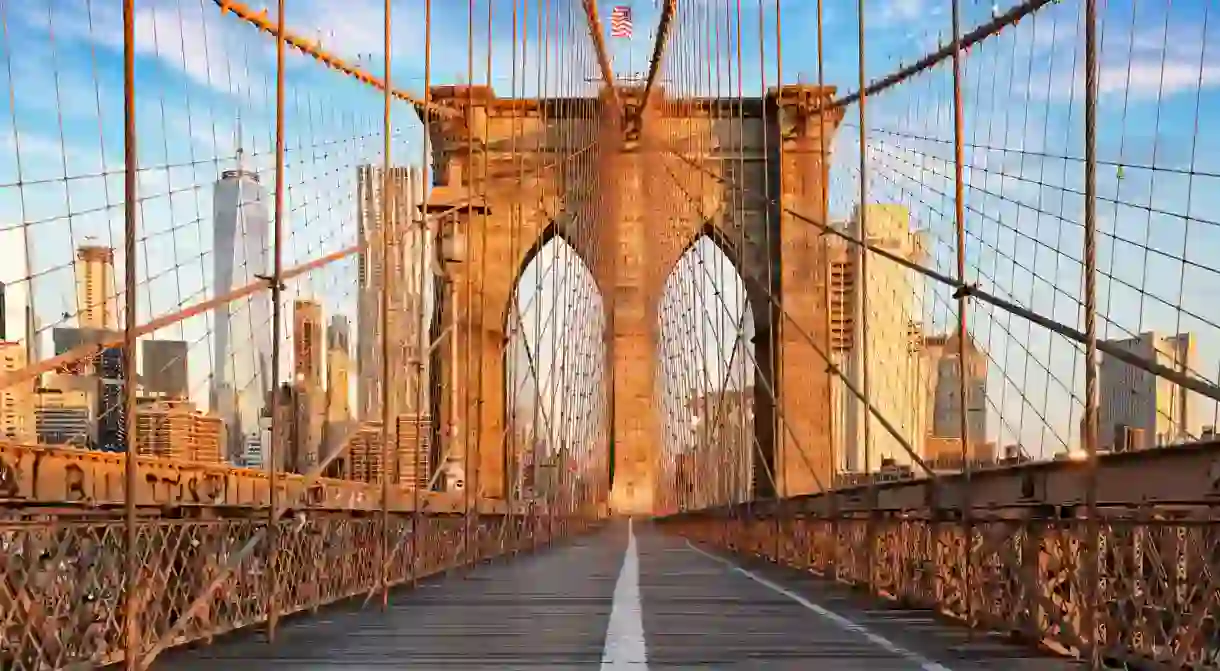A Visit to the Brooklyn Bridge, Done Differently

Whichever end of the Brooklyn Bridge you choose to start with, loads of activities await you once you’ve taken in some lovely views of the city. Make the most of your day with our guide to this New York landmark.
Constructed over 14 years, the Brooklyn Bridge was the first steel-wire suspension bridge. Its opening ceremony in 1883 was a momentous enough occasion that US President Chester A Arthur and New York Governor (and future president) Grover Cleveland were in attendance. There, they witnessed Emily Warren Roebling, who oversaw the completion of construction, become the first person to cross the bridge, which she did in a horse-drawn carriage while carrying a rooster, a symbol of victory.
The bridge connected Manhattan and Brooklyn and was originally dubbed the New York and Brooklyn Bridge, but its name was shortened officially to the Brooklyn Bridge when the city government passed a law changing its title in 1915. Strolling over the bridge – the pedestrian walkway of which is only a little more than a mile long – is a great way to take in a view of the New York City skyline as well as the harbor, the Manhattan Bridge and the Statue of Liberty in the distance. It’s a must-visit attraction for anyone looking to get a sweeping view of New York while enjoying one of its greatest engineering marvels. You can enter in either borough, Manhattan or Brooklyn, and there is plenty to do once you cross over to your destination. So make a day of your visit with Culture Trip’s guide to what to do and see around this New York landmark.
Brooklyn War Memorial
Memorial

Dedicated in 1951 and commissioned by Robert Moses, the Brooklyn War Memorial was meant to be one of five World War II monuments the notorious city planner was to install in each borough. Brooklyn’s was the only one that was built. Located inside Cadman Plaza, the granite and limestone memorial featuring two large sculptures representing victory and family is dedicated to the more than 300,000 “heroic men and women of the borough of Brooklyn who fought for liberty in the second world war 1941-1945,” as the inscription reads.
Brooklyn Historical Society
Museum

New York Transit Museum
Building, Museum

Mmuseumm, New York

Only three people can enter this tiny museum at a time. The space is only six feet (1.8 meters) by six feet and contained within a former freight elevator in Chinatown. But its size isn’t the only thing that sets Mmuseumm apart; it employs what it terms “object journalism,” a type of storytelling using unique artifacts from around the world, which are swapped out annually. Current showcases include ISIS currency, objects made by prisoners and last meal receipts, among others. The displays are accessible 24 hours a day through viewing windows.
New Museum
Museum, Store, Building, Cinema, Forest

African Burial Ground National Historic Monument, Broadway
Memorial, Park

Just two blocks from New York City Hall, a building constructed using slave labor, is the African Burial Ground National Monument, a six-acre (2.5-hectare) former cemetery containing upwards of 15,000 intact skeletal remains of enslaved and free Africans who lived and worked in colonial New York. The site was discovered during the construction of a 34-story federal office building during which the bones were unearthed, which “altered the understanding and scholarship surrounding enslavement and its contribution to constructing New York City,” according to the National Park Service site. In 2006 the memorial, chosen from 60 proposals, was unveiled. The 25-foot (eight-meter) granite monument features a globe emphasizing the Atlantic area within the “Circle of Diaspora,” a reference to the Middle Passage journey slaves took from West Africa to the West Indies.













